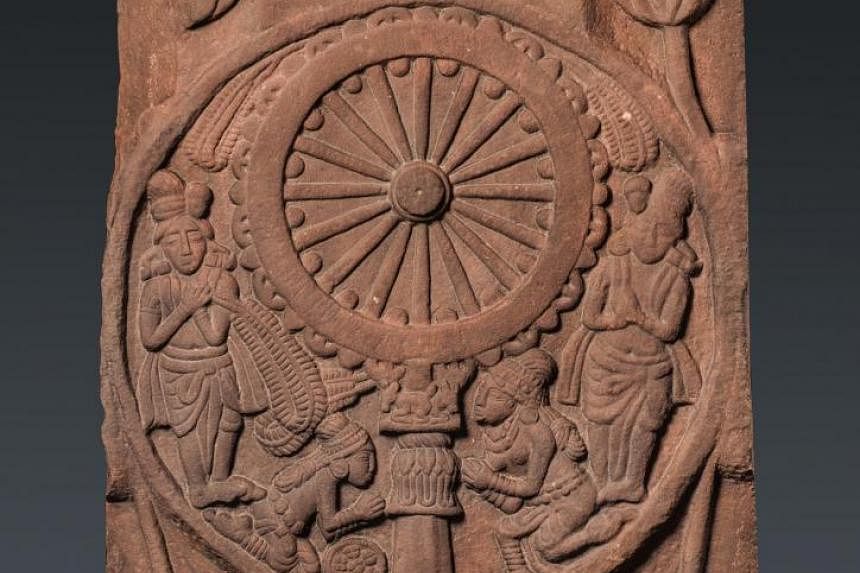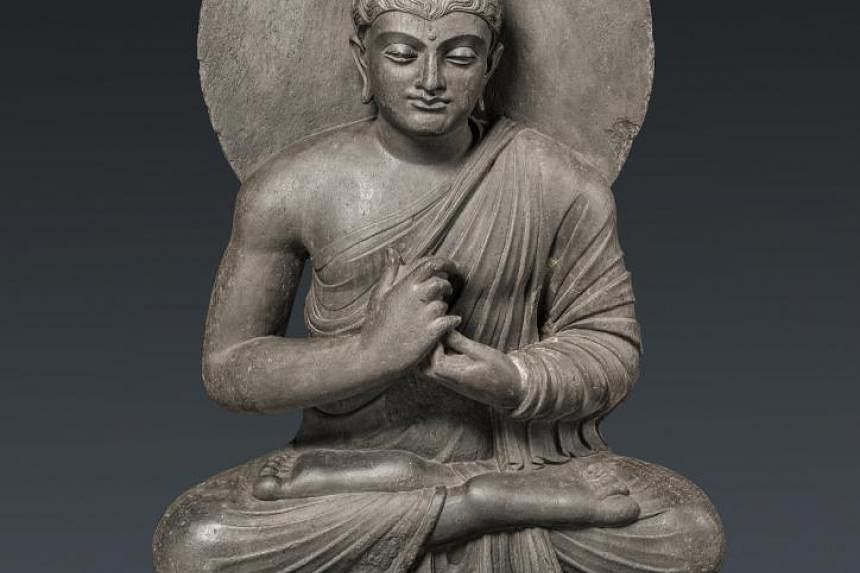A statuette of Buddha is frozen in mid-step, as though about to descend invisible stairs post-Nirvana. Behind glass panels, stucco Buddha heads appear to be sleeping or are deep in meditation. A giant, mysterious footprint in a corner belongs to no mortal foot.
Such peaceful tableaux can be found in the Asian Civilisations Museum's (ACM) latest exhibition, Treasures From Asia's Oldest Museum. It is on till Aug 16.
Spanning almost 2,000 years, it showcases 81 pieces of Buddhist art on loan from the Indian Museum, Kolkata, to chart the evolution of Buddhist imagery from the second century BC to the 12th century.
These are "some of the most important works of the Indian Buddhist culture", says ACM director Alan Chong.
The objects on display trace cultural shifts and changes in style, as the ancient Indian Shunga dynasty (circa 187 to 78BC), Gandhara kingdom (circa 1500 to 500BC, in what is Pakistan today), Gupta Empire (AD320 to 550) and Pala Empire (8th to 12th century) rose and fell.
Highlights include a 1.2m-tall sandstone Standing Buddha from the Gupta period, with smooth robes and its right hand held up in a protecting gesture.
"This is the very pinnacle of Indian art, considered by most lovers of Indian art to be its high point," says the museum's senior curator Theresa McCullough, pausing in front of it during a press preview. "A very serene figure, heavily influencing future depictions of the Buddha from there on."
Later examples include a 10th-century, Pala basalt stele of Queen Maya giving birth to Siddharta Gautama. It was found at the ruins of Nalanda, a large Buddhist monastery in India dating back to the 5th century, which once attracted scholars from Tibet and Central Asia.
The artefacts are arranged to present a chronological narrative of the life of Buddha. There are depictions of Buddha's humble lifestyle and a plethora of strong female queens and goddesses including Maya and Tara, as Bajrajana Buddhism came to the fore.
Founded in 1814, the Indian Museum in Kolkata is one of the oldest museums in the world.
Treasures, a first-time collaboration between the Singapore and Indian museums, took two years to put together and marks 50 years of diplomatic relations between both countries.
The exhibition's opening on Thursday was co-officiated by Singapore's Minister of Culture Lawrence Wong and his Indian counterpart, Dr Mahesh Sharma. Both sides are in talks for a second collaboration.
Earlier this year, the Asian Civilisations Museum took a Peranakan-themed exhibition to India's Delhi Museum. Last month, the National Heritage Board set up an Indian Heritage Centre in Singapore.
Curator McCullough says of the Treasures exhibition: "It solidifies the close relationship between museums and between the two ministries of culture. We're very happy to have these relationships because they don't usually lend out their artefacts to other museums in the world."
FIVE HIGHLIGHTS
STANDING BUDDHA
Gupta, circa 5th century, Sarnath sandstone, 120x51x16cm
Considered one of the most beautiful and serene statues in Buddhist history for its sublime, simple imagery. It came to influence Buddhist art for many years after. His pose and hands signal the subduing of fear and the promise of protection.
FOOTPRINT OF THE BUDDHA
Pala, circa 11th century, Bodhgaya, stone, 21.1x71cm
The Buddhapada, or Buddha's footprint, is marked with several auspicious symbols, including a chakra (wheel). The footprint came to be a popular symbol in Buddhism and has been seen in many images, representing proof of Buddha's earthly existence.
QUEEN MAYA GIVING BIRTH TO SIDDHARTHA GAUTAMA
Pala, circa 10th century, Nalanda basalt, 37.8x24.2x10cm
A depiction of the birth of Buddha, flanked by the gods Brahma, Vishnu and Indra. Maya imitates the pose of ancient fertility goddesses. The statue belongs to the Bajrajana type of Buddhism, or Tantric Buddhism, placing an emphasis on female energy and presence.
WORSHIP OF THE WHEEL OF THE LAW
Shunga, circa 2nd century BC, Bharhut, sandstone 50x50x14cm
One of the oldest pieces in the exhibition, the artefact depicts Buddha's First Sermon and represents a simpler time when disciples attempted to achieve Nirvana (an enlightened state) without an image of Buddha, but through an imitation of his lifestyle.
BUDDHA PREACHING
Gandhara, circa 2nd century, Loriyan Tangai, schist, 79x45x16cm
The statue represents Buddha turning the Wheel of the Law - a metaphor for the rapid spiritual change brought about by his teachings - and came to be one of the default images of Buddha. This is an evolution from the sandstone images, where, instead of people carrying out religious deeds, Buddha takes centrestage.





